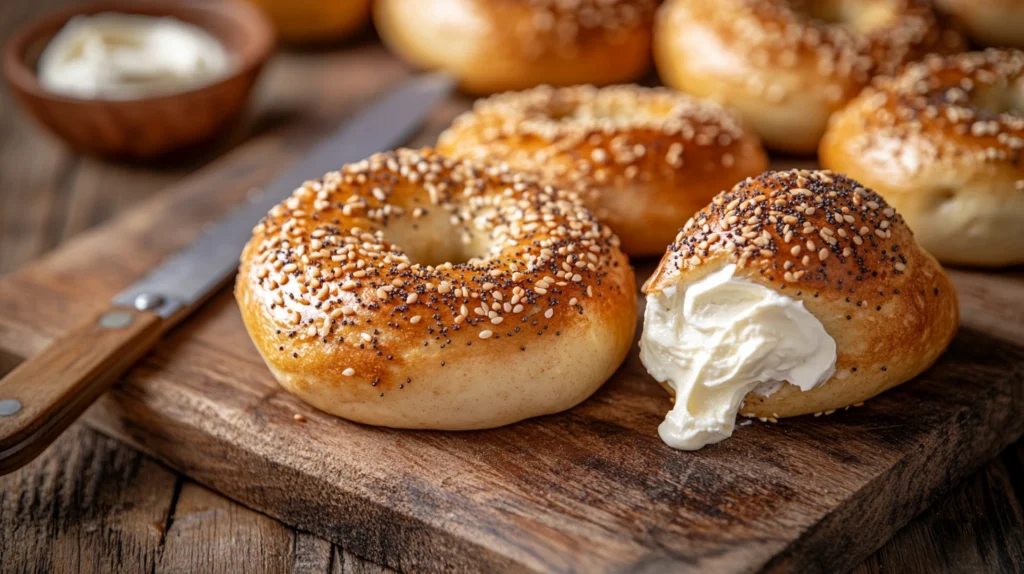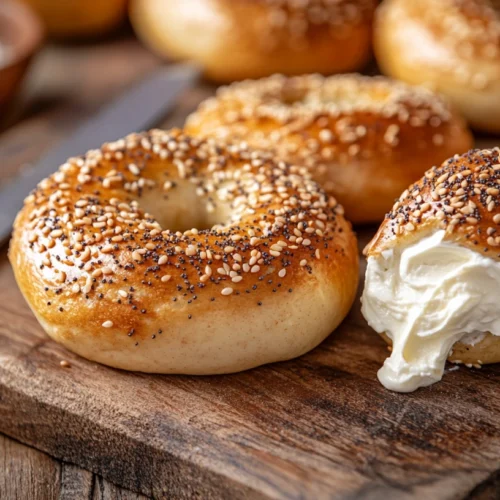Homemade Easy Sourdough Bagels Recipe may seem intimidating, but this simple homemade sourdough bagel recipe breaks it down into easy steps, making it accessible for both beginners and seasoned bakers. Whether you enjoy them plain, topped with sesame seeds, or slathered with cream cheese, these bagels will be a staple in your kitchen.
Let’s dive into what makes Easy Sourdough Bagels Recipe unique and why you should give them a try!

What Makes This Easy Sourdough Bagels Recipe Unique?
This easy sourdough bagels recipe stands apart from traditional yeast-risen bagels due to its natural fermentation process. Instead of using store-bought yeast, homemade Easy Sourdough Bagels Recipe rely on a sourdough starter, which is a mixture of flour and water that captures wild yeast and beneficial bacteria from the environment. This process results in a deeper flavor, improved digestibility, and a chewier texture.
By following this easy sourdough bagels recipe, you can create bagels that are more flavorful and naturally leavened. Unlike commercially made bagels, these sourdough bagels have a rich, tangy taste that develops over time. If you’re looking for a healthier, homemade alternative to store-bought bagels, then this sourdough bagels recipe is the perfect choice!
Key Differences Between Sourdough and Yeast Bagels
- Fermentation Time – Easy Sourdough Bagels Recipe require a longer rise time, often involving an overnight cold fermentation that enhances flavor and texture.
- Flavor Profile – The tangy, slightly sour taste of sourdough bagels comes from the natural lactic acid bacteria in the starter. Yeast bagels tend to have a more neutral, mild flavor.
- Digestibility – The extended fermentation of sourdough helps break down gluten, making it easier on the stomach for those sensitive to wheat.
- Shelf Life – Thanks to natural acids in sourdough, these bagels tend to stay fresh longer without preservatives.
Texture and Chew
Easy Sourdough Bagels Recipe have a firmer crust and a denser, chewier inside, achieved through:
- The fermentation process, which strengthens gluten development
- The classic boiling step before baking, which gives bagels their signature texture
Now that you know why sourdough bagels are so special, let’s look at the essential ingredients you’ll need.
Essential Ingredients for Homemade Easy Sourdough Bagels Recipe
To make delicious Easy Sourdough Bagels Recipe , you only need a few basic ingredients.
Main Ingredients
- Bread Flour (500g / 4 cups) – High-protein flour helps create the classic chewy texture. You can substitute with all-purpose flour, but the chewiness may be reduced.
- Active Sourdough Starter (100g / ½ cup) – A mature, bubbly starter is crucial for a good rise and tangy flavor.
- Water (250g / 1 cup) – Hydrates the dough and activates fermentation.
- Salt (10g / 2 tsp) – Enhances flavor and helps control yeast activity.
- Honey or Malt Syrup (15g / 1 tbsp) – Optional, but adds a slight sweetness and traditional bagel flavor.
Boiling Water Additions (For Texture and Shine)
- Baking Soda (1 tbsp) – Helps create a golden crust.
- Honey or Malt Syrup (1 tbsp) – Adds a slight sweetness and gives bagels a traditional shine.
Optional Toppings
- Sesame seeds
- Poppy seeds
- Everything bagel seasoning
- Coarse salt
- Dried onion or garlic flakes
Step-by-Step Guide: How to Make Easy Sourdough Bagels Recipe at Home
Making Easy Sourdough Bagels Recipe takes time, but it’s worth the effort. The process involves:
- Feeding your sourdough starter – Ensuring it’s active and ready to leaven the dough.
- Mixing the dough – Combining ingredients and developing gluten.
- First rise (bulk fermentation) – Allowing the dough to ferment at room temperature.
- Shaping the bagels – Forming the classic round shape with a hole in the center.
- Cold fermentation – Placing the bagels in the fridge overnight for enhanced flavor.
- Boiling the bagels – Cooking them briefly before baking to create the chewy texture.
- Baking – Achieving a golden crust and perfectly baked inside.
Let’s start with the first step: preparing your sourdough starter.

Feeding Your Easy Sourdough Bagels Recipe Starter
- Remove from the fridge – Take out ¼ cup of your sourdough starter and place it in a clean jar.
- Feed the starter – Add ¼ cup of water and ¼ cup of flour. Mix well and leave at room temperature.
- Wait for activity – Within 4-6 hours, the starter should double in size and have bubbles.
- Perform a float test (optional) – Drop a small spoonful of starter into a glass of water. If it floats, it’s ready to use!
Instructions for Mixing the Dough
- Combine Ingredients
- In a large mixing bowl, combine:
- 500g (4 cups) bread flour
- 100g (½ cup) active sourdough starter
- 250g (1 cup) warm water
- 10g (2 tsp) salt
- 15g (1 tbsp) honey or malt syrup (optional)
- Mix with a wooden spoon or dough hook until all ingredients come together into a shaggy dough.
- In a large mixing bowl, combine:
- Kneading the Dough
- Turn the dough onto a clean surface and knead for 8-10 minutes until it becomes smooth and elastic.
- Since this is a stiff dough, you might need to press hard and use a rocking motion to knead properly.
- Alternatively, use a stand mixer with a dough hook on low speed for 6-8 minutes.
- First Rest (Autolyse)
- Cover the bowl with a damp towel and let it rest for 30 minutes. This allows the flour to fully absorb the water and makes the dough easier to shape later.
First Rise (Bulk Fermentation)
Sourdough fermentation takes longer than commercial yeast, but this slow rise develops great flavor.
How to Ferment the Dough
- Initial Fermentation
- After resting, knead the dough lightly for a minute to build more strength.
- Cover the bowl with plastic wrap or a damp towel and let it rise at room temperature (21-24°C / 70-75°F) for 4-6 hours.
- The dough should increase by about 50% in volume (not necessarily double like other bread doughs).
- Check for Readiness
- The dough should feel slightly puffy and pass the poke test—press a finger into the dough, and if it springs back slowly, it’s ready.
- If it’s still dense, let it ferment another hour.
Once the dough has properly risen, it’s time for the fun part—shaping the bagels!
Shaping the Bagels
Proper shaping is key to getting the classic bagel look and texture.
Cold Fermentation for Flavor Development
Letting the shaped bagels rest in the fridge overnight improves their taste and texture.
How to Cold Ferment Bagels
- Place the shaped bagels on a parchment-lined baking sheet.
- Cover them loosely with plastic wrap or a clean kitchen towel.
- Refrigerate for 12-24 hours (the longer, the better the flavor).
💡 Why This Step Matters
- Slows down fermentation, creating a more complex, tangy flavor.
- Helps bagels hold their shape better when boiled and baked.
- Develops a chewier texture.
Why Do You Boil Bagels?
- The hot water gelatinizes the starch on the surface, forming a shiny, firm crust.
- It prevents the bagels from spreading too much during baking.
How to Boil
- Add 1 tbsp baking soda and 1 tbsp honey or malt syrup to the water. This gives the bagels a golden crust and slight sweetness.
- Carefully drop 2-3 bagels into the boiling water at a time.
- Boil for 30-60 seconds per side (the longer they boil, the chewier they will be).
- Remove with a slotted spoon and place them back on the parchment-lined tray.
💡 Pro Tip: If you want extra-crispy bagels, sprinkle the boiled bagels with cornstarch before baking.
Baking to Perfection
Now that your bagels have been boiled, it’s time to bake them to golden perfection.

How to Bake Easy Sourdough Bagels Recipe
- Preheat the Oven
- Set your oven to 220°C (425°F) and allow it to fully heat up before baking.
- If you have a baking stone, place it inside to help create an even bake.
- Add Toppings (Optional)
- If you’re using toppings like sesame or poppy seeds, brush the boiled bagels with a bit of egg wash (1 beaten egg + 1 tbsp water) and sprinkle the seeds generously.
- You can also use “everything bagel” seasoning, coarse salt, or dried onion flakes.
- Bake the Bagels
- Place the tray in the middle rack of the oven.
- Bake for 20-25 minutes, rotating the tray halfway through to ensure even browning.
- The bagels are done when they are deep golden brown and sound hollow when tapped on the bottom.
- Cool and Enjoy
- Transfer the baked bagels to a cooling rack and let them rest for at least 20 minutes before slicing.
- Enjoy them warm or at room temperature with your favorite toppings!
Delicious Topping Ideas Easy Sourdough Bagels Recipe
Easy Sourdough Bagels Recipe are incredibly versatile. Here are some classic and creative topping ideas:
Classic Toppings:
- Sesame Seeds – Adds a nutty crunch.
- Poppy Seeds – A traditional choice with a mild, nutty flavor.
- Everything Bagel Seasoning – A blend of sesame seeds, poppy seeds, garlic, onion, and salt.
- Coarse Salt – Perfect for pretzel-like bagels.
Sweet Toppings:
- Cinnamon Sugar – Sprinkle with cinnamon and sugar for a sweet touch.
- Dried Cranberries & Walnuts – Mix into the dough for extra flavor.
Savory Additions:
- Cheddar & Jalapeño – Adds a spicy, cheesy kick.
- Parmesan & Garlic – Sprinkle with grated Parmesan and minced garlic before baking.
Serving Suggestions Easy Sourdough Bagels Recipe
Easy Sourdough Bagels Recipe are delicious on their own but even better when paired with the right spreads and fillings.
Best Spreads:
- Cream Cheese (Plain or Flavored) – Classic and creamy.
- Butter & Honey – Simple but rich in flavor.
- Avocado & Sea Salt – A healthy, creamy option.
- Hummus & Cucumber – A great dairy-free spread.
Bagel Sandwich Ideas:
- Lox & Cream Cheese – Smoked salmon, cream cheese, red onion, and capers.
- Egg & Cheese – A hearty breakfast option.
- Turkey & Swiss – A delicious lunch choice.
- Peanut Butter & Banana – Great for a protein-packed snack.
Common Mistakes to Avoid
Making Easy Sourdough Bagels Recipe takes practice. Here are some common mistakes:
❌ Bagels don’t hold their shape
✅ Make sure you allow enough cold fermentation time in the fridge (at least 12 hours). This helps them keep their structure.
❌ Bagels have a tough crust
✅ Avoid overboiling. 30-60 seconds per side is enough.
❌ Bagels don’t brown well
✅ Increase your oven temperature slightly and bake a few minutes longer.
Pair Your Bagels with a Refreshing Salad – Try this Easy Broccoli Cauliflower Salad Recipe for a nutritious and crunchy side.Need a Sweet Treat? – Complement your bagels with these Lemon Cookies for a citrusy dessert.For a Hearty Lunch Option – If you love homemade bread, you’ll also enjoy this Juicy Chicken Burger Recipe made with fresh ingredients.
Frequently Asked Questions
1. How long do sourdough bagels last in the fridge?
Sourdough bagels can last up to 5-7 days in the refrigerator when stored in an airtight container or a ziplock bag. However, refrigeration can dry them out, so it’s best to toast or reheat them before eating. For longer storage, freeze them instead—sourdough bagels freeze well for up to 3 months when properly wrapped.
2. Are sourdough bagels healthier?
Yes! Sourdough bagels are considered healthier than traditional yeast-based bagels because:
- Easier to digest – The natural fermentation process helps break down gluten.
- Lower glycemic index – Sourdough digestion slows down sugar absorption, preventing blood sugar spikes.
- More nutrients – Fermentation enhances the bioavailability of minerals like iron, zinc, and magnesium.
- No artificial additives – Homemade sourdough bagels are free of preservatives and unnecessary sugars.
3. Why are my sourdough bagels tough?
If your sourdough bagels are too tough or dense, it may be due to:
- Over-kneading – Too much kneading can make the dough too tight.
- Overboiling – Boiling bagels for too long (more than 60 seconds per side) creates a thicker, tougher crust.
- Underproofing – If the dough hasn’t risen enough, it won’t be airy and will remain dense.
- Too much flour – Using too much flour when shaping or kneading can make the bagels dry and tough.
4. How to know when sourdough bagels are done bulk fermenting?
Bulk fermentation is done when:
- The dough has increased by about 50% in volume (not necessarily doubled like regular yeast dough).
- It passes the poke test – Lightly press the dough with your finger; if it springs back slowly, it’s ready.
- The texture feels light and slightly puffy, rather than dense and stiff.
- You see small bubbles on the dough’s surface, indicating active fermentation.
Conclusion
Making homemade sourdough bagels is a rewarding experience that results in a deeply flavorful, chewy, and satisfying breakfast staple. While the process takes time due to natural fermentation, the taste and texture are well worth the effort. With this easy sourdough bagels recipe, you can confidently bake your own bagels at home.
Whether you enjoy them plain, topped with seeds, or turned into a delicious sandwich, this homemade sourdough bagel recipe ensures perfect results every time. These chewy sourdough bagels are sure to become a favorite in your kitchen. Give this easy sourdough bagels recipe a try, and enjoy fresh, homemade bagels anytime. Happy baking! 🥯✨

Easy Sourdough Bagels Recipe – Chewy, Flavorful & Homemade
Equipment
- Large mixing bowl
- Digital kitchen scale (recommended)
- Wooden spoon or stand mixer with dough hook
- Bench scraper (for dividing dough)
- Baking sheet with parchment paper
- Large pot (for boiling bagels)
- Slotted spoon
- Wire cooling rack
- Pastry brush (for egg wash, if using)
Ingredients
- Dough:
- 500 g 4 cups bread flour (high protein for chewiness)
- 100 g ½ cup active sourdough starter (fed and bubbly)
- 250 g 1 cup warm water
- 10 g 2 tsp salt
- 15 g 1 tbsp honey or malt syrup (optional, enhances flavor)
- For Boiling the Bagels:
- 1 tbsp baking soda for a shiny, chewy crust
- 1 tbsp honey or malt syrup adds a slight sweetness
- Optional Toppings:
- Sesame seeds
- Poppy seeds
- Everything bagel seasoning
- Coarse salt
- Dried onion or garlic flakes
Instructions
- 1️⃣ Feed the Sourdough Starter
- If your starter is refrigerated, feed it 4-6 hours before using until bubbly and active. Perform a float test by dropping a spoonful into water; if it floats, it’s ready!
- 2️⃣ Mix the Dough
- In a large bowl, combine bread flour, active sourdough starter, warm water, salt, and honey/malt syrup.
- Mix with a wooden spoon or stand mixer until a shaggy dough forms.
- Knead the dough for 8-10 minutes by hand (or 6 minutes in a stand mixer) until smooth and elastic.
- 3️⃣ Bulk Fermentation (First Rise)
- Cover the bowl and let the dough ferment at room temperature for 4-6 hours, until it increases by 50% in volume (not necessarily doubled).
- Perform the poke test—gently press the dough; if it springs back slowly, it’s ready.
- 4️⃣ Shape the Bagels
- Divide the dough into 8 equal pieces (~100g each).
- Shape using one of two methods:
- Poke Method: Roll each piece into a ball, poke a hole in the center, and stretch gently.
- Rope & Loop Method: Roll into a 10-inch rope, wrap it around your fingers, and seal the ends.
- Place the shaped bagels on a parchment-lined baking sheet.
- 5️⃣ Cold Fermentation (Overnight Rest for Flavor)
- Cover loosely with plastic wrap and refrigerate for 12-24 hours.
- This slow fermentation enhances the flavor and strengthens the gluten.
- 6️⃣ Boil the Bagels
- Bring a large pot of water to a rolling boil.
- Add 1 tbsp baking soda and 1 tbsp honey or malt syrup (this gives bagels their signature shine).
- Boil bagels 30-60 seconds per side (longer boiling = chewier texture).
- Remove with a slotted spoon and place back on the baking sheet.
- 7️⃣ Add Toppings (Optional)
- While still wet from boiling, sprinkle bagels with sesame seeds, poppy seeds, or everything seasoning.
- 8️⃣ Bake the Bagels
- Preheat oven to 220°C (425°F).
- Bake for 20-25 minutes, rotating the tray halfway through.
- Bagels are done when golden brown and sound hollow when tapped.
- 9️⃣ Cool and Enjoy!
- Transfer bagels to a wire rack and cool for at least 20 minutes before slicing.
- Serve with cream cheese, butter, or your favorite toppings!
Notes
Denser Texture? Boil bagels for 90 seconds per side.
Soft Bagels? Reduce boiling time to 30 seconds per side.
Storage: Store at room temperature for 2-3 days or freeze for up to 3 months.

